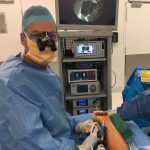Small Joint Arthritis
Introduction
Any joint in the hand or wrist can be affected by arthritis. There are a number of different types of arthritis, with different causes. Here I will discuss arthritis of the small joints, wrist arthritis is under the wrist banner.
Osteoarthritis is by far the most common type of arthritis in the hand, either from wear and tear or following trauma. Inflammatory arthritis (like rheumatoid arthritis) which used to cause crippling hand deformities, has largely been conquered by rheumatologists. Some inflammatory arthritis can be difficult to control with medication, though much less frequently than a few years ago.
Osteoarthritis
A normal cartilage joint is where movement occurs between two (or more) bones in the skeleton. The inside of the bones is like a honeycomb, and this is contained within a dense shell of hard bone, of varying thickness. At a joint the dense shell of bone is called “subchondral” bone, meaning “beneath the cartilage”. This is because each bone has cartilage applied to the dense bone. So at a normal joint, we have cartilage moving against cartilage.
In a normal joint, there is virtually no friction between the two opposed cartilage surfaces. In osteoarthritis, the cartilage splits, frays, and thins. Eventually, there will be bone against bone. Despite some claims in the media, it is not possible to regenerate cartilage with dietary supplements or drugs.
The pain of osteoarthritis arises from bone rubbing on bone. Patients will experience varying degrees of pain, grinding and loss of motion. Sometimes the joints become crooked also. However, the purpose of any treatment for osteoarthritis is to relieve pain.

PIPJ arthroplasty with DIPJ fusion

PIPJ arthroplasty 2 months following surgery
Treatments
- Medicines: sometimes simple analgesia, like paracetamol, is all that is required. Some patients will find that anti-inflammatories help more than paracetamol, but these do tend to have more side effects. Narcotic analgesics should be avoided. These are highly addictive, and so should only be used for conditions that cause short term pain. None of these medicines affect the underlying problem.
- Steroid injections: these may temporarily help the pain from an arthritic joint. They do not change the underlying problem and are generally a short term solution. Occasionally a positive response from a steroid injection can be helpful in understanding the source of the pain when there is a doubt in the diagnosis.
- Splints: these may help unload the affected joint, and in some patients are a great help. Especially around the thumb CMC joint, some patients find this a useful treatment for many years.
- Surgery: surgery can most definitely address the underlying problems. There are three basic approaches.
- fusion – the affected joint is deleted, by making the two adjacent bones heal together, forming one bone.
- arthroplasty – the joint surfaces are replaced, as in a hip or knee replacement
- excision arthroplasty – a space is created between the two bony surfaces, by excising part or all of one of the affected bones.
The three types of surgery have different advantages and disadvantages, depending on which joint is affected (see diagram).
The three most commonly affected joints in the hand are the distal interphalangeal joint, the proximal interphalangeal joint and the basal (CMC) joint of the thumb. These joints normally contribute different amounts of motion to a digit, by virtue of their different ranges of motion, and also by their position in the joint (see diagram – Littler drawing).
Distal interphalangeal joint (see first photo)
Because of this joint’s location in the finger, removing its motion removes very little function. This is a reliable operation, with durable results over time. The surgery may be performed through a small transverse incision.
The main reason to perform this operation is a pain.
Proximal interphalangeal joint (see photo)
Because of the location of this joint in the digit, it is preferable to preserve motion. Although fusion of this joint successfully treats pain, an arthroplasty is preferable where possible, as it preserves motion.
Arthroplasties are generally either silicone or anatomical (see photo).
The reason to perform arthroplasty is to relieve pain. If a joint is crooked before arthroplasty, it will probably be crooked after. Also, the effects on motion are a little unpredictable. Sometimes motion is improved, sometimes it is the same and sometimes, but rarely, it is less.
Like all arthroplasties in the body, those in the PIPJ tend to wear out over time.
Thumb carpometacarpal joint (CMC)
This joint is where the thumb joins the wrist. It allows the thumb to roll around to face the fingertips. It is normally both mobile and stable and must bear significant forces as the thumb works against the 4 digits.
Sometimes when there is arthritis of the thumb CMCJ, there is also arthritis of the neighboring wrist joint (STT joint), of varying degrees of severity (see the photo of x-ray).
There may also be a collapse of the MPJ, which can hyperextend. This must be corrected with any surgery of the CMC joint, or it can lead to failure of the surgery.
There are five main surgical options. These have different pros and cons and will suitable in different circumstances.
i arthroscopic debridement is using “keyhole” surgery to “clean up” the joint. This is suitable for younger patients with loose bodies and catching symptoms, or prior to ligament stabilization to assess the cartilage surfaces. It does not make the cartilage come back but is effective to receive catching symptoms.
After arthroscopic debridement, early unrestricted activity is possible, though a degree of post-surgical discomfort is to be expected for 2-4 weeks.
Improvement in catching symptoms should be immediate.
ii ligament stabilization may improve symptoms in early osteoarthritis if there is still some cartilage remaining.
After ligament stabilization, a splint is worn for 8 weeks, and loading avoided for 12 weeks.
iii CMC fusion is where the joint surfaces are excised and the two bones compressed together with surgical fixation (see photo). This is suitable for younger patients (40’s-50’s) who require powerful pain free grip and pinch. The downside is inability to get the thumb completely in the plane of the palm. Any STT arthritis is not addressed by this procedure.
After surgery, a splint is used until bone healing is confirmed on x-ray at about 8 weeks. Then the patient can return to unrestricted activities.
iv CMC arthroplasty is an option for patients (50’s-60’s) who wish to maintain some power, avoid trapeziectomy and maintain motion. There are many implants which have been unsuccessful in the past. My preference is the “pyrodisc” interposition arthroplasty, which is based on the rib cartilage arthroplasty designed by William Littler in the 1980’s. The pyrodisc is made from pyrocarbon, heat treated carbon, with a hardness similar to bone. The joint surfaces are resected, the bony ends are prepared to accept a suitable sized pyrodisc, and the implant is stabilized with a strip of tendon, which is sutured around the joint (see photo).
After this surgery, a splint is used to support the tendon stabilisation, for 8 weeks. Loading commences at 12 weeks.

Top: thumb CMCJ fusion, Bottom: thumb CMCJ pyrodisc arthroplasty with MPJ fusion
Generally, the pain from the arthritis is markedly improved. Some residual aching from the surgery, especially with activity, is not uncommon in the first 6 months following surgery.
v trapeziectomy (+/- suspensionplasty) is a surgery which was first reported in the 1940’s. The trapezium is excised, leaving a gap. As expected, this is usually successful in relieving pain, as the arthritic surfaces are no longer in contact. There is usually loss of pinch strength, which occurs because the platform of the thumb has been destabilised. When the muscles used for pinch contract, they will compress the trapeziectomy space, rather than exerting force at the thumb tip. Over time, the metacarpal can descend into space, and about the scaphoid, which is a very difficult problem to cure.
Suspensionplasty was introduced in the 1980s in an attempt to improve pinch strength and reduce the problem of metacarpal descent. It is unclear if it is effective or necessary, or not. Its use should be at the discretion of the surgeon and will depend on the circumstances.
After trapeziectomy, a splint is used for support for 8 weeks, but motion begins a week after the surgery. Strength is commonly slow to recover, taking 6-9 months in many cases.


